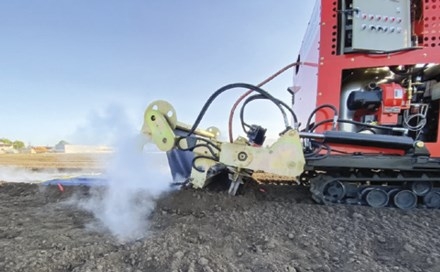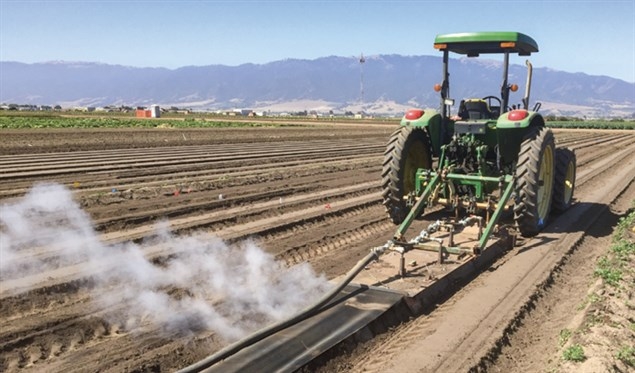From the weekly newspaper for California Agriculture, Ag Alert • Dec. 2, 2020 • California Farm Bureau Federation
Advisors seek practical use of steam in weed control
By Bob Johnson
Steam-treating a shallow band of soil within the seed line before planting may offer, when combined with advanced cultivators, an economical weed control option for organic farmers and conventional growers looking to reduce herbicide use.
University of California specialists said their research in Salinas Valley vegetable fields this year showed the technique can significantly reduce weed pressure and hand-weeding time, and even produce larger and more vigorous lettuce plants.
"We're reducing the hand-weeding time," UC Cooperative Extension weed specialist Steve Fennimore said. "The plants were larger, significantly larger."
Fennimore, who has been studying steam as a way to control weeds and soil diseases since strawberry growers first faced the loss of the fumigant methyl bromide, presented his latest research during the UC Online 2020 Pest Management Series in early November.
Steam works as well as fumigation in reducing weeds and soil-borne disease pressure, he said, but previous efforts have shown that treating the entire bed can be too expensive and time-consuming to be practical in most situations.
"With banded steam, you treat less of the bed," Fennimore said. "Our target would be to heat the soil to about 150 degrees Fahrenheit; but you would only need to steam 2 or 3 inches deep. Then you could seed lettuce in the seed line and cultivate outside of it."
Fennimore and UC graduate research fellow Nelly Guerra tested steam this year in three Salinas Valley trials—two on lettuce and the third on spinach—as they compared weed pressure after steam-treating the seed line with and without hydrogen peroxide, an organically approved compound that helps spread the heat.

The researchers said banded steam showed similar efficacy in the second lettuce trial, reducing nightshade and shepherd's purse by 75% to 90%, and significantly reducing little mallow when the hydrogen peroxide was added to the steam.
The steam treatment reduced hand-weeding time by 20% to 40%, and reduced lettuce-drop damage by 54% to 67%, they said.
Another set of Salinas Valley vegetable trials showed the promise of GPS-controlled, autonomous weeders that cultivate without a driver, outside and within the seed line.
"This project comes down to labor," said Elizabeth Mosqueda, weed science professor at California State University, Monterey Bay. "It takes a lot of manpower to remove weeds from one lettuce field. How can we decrease labor costs in leafy green production? The other part of this is the number of herbicides available; the last formulation for lettuce was introduced in 2014."
Mosqueda tested two autonomous weeders in Salinas-area commercial lettuce fields: the relatively small DINO weeder from France and the larger Farmwise Titan robotic weeder.
"Both of these companies want to get to the point that one operator can be in the field with multiple machines," Mosqueda said. "But autonomous weeders can already weed between and within rows at the same time."
The time saved by using the autonomous weeders that cultivate within the rows varied with the amount of weed pressure in the three fields where they were tested, she said: Field one had exceptionally light weed pressure, and the autonomous cultivators did not save hand-weeding time. But in field two, with higher weed pressure, hand-weeding time was reduced from 11.1 hours per acre to 9.4 hours. The greatest reduction in hand-weeding time, from 16.9 hours to 9.9 hours, came in the most heavily infested third field.
"Our autonomous weeders controlled about 85% of the weeds, compared to 40% with a standard cultivator," Mosqueda said. "The uncultivated seed line is the area of concern. Weeds between the plants are typically removed by hand."
Although advanced cultivators may be the answer to more effective control of weeds after they emerge, Fennimore said steam could become a more economical method of preventing emergence.
"How do you get pre-emergent weed control that is compliant with organic regulations?" he asked. "Steam is the oldest method of soil disinfestation. The guys in Denmark have shown it can be an economical method of weed control."
Treating just a shallow, narrow band of soil within the seed line makes steam more affordable, but Fennimore said he hopes to go even further in reducing the time, fuel and money needed to use steam.
"Spot steaming is something I would like to try," he said. "You could do a 4-inch square and plant a vegetable in the spot. You would need precision equipment. We want it to be the cheapest; we want to go faster and use less fuel."
The steady growth of organics in strawberries has taken Fennimore back to the question of how to treat the soil before planting the crop.
"The hand-weeding costs in organic strawberries have gone up a lot; it's up to $3,700 an acre," he said.
Fennimore did a series of steam trials at a strawberry nursery in the mountain region near the Oregon border, and in commercial fields in the Watsonville-Salinas area.
He said steam with or without mustard meal was as effective as fumigation with chloropicrin in ridding soil of Verticillium wilt pathogens, and yields were comparable to fumigated plots.
One promising insight coming from the trials, he said, is it looks as though steam and mustard meal have a synergistic effect when used together.
"The steam looks like it releases biofumigant compounds from the mustard meal," Fennimore said.
(Bob Johnson is a reporter in Sacramento. He may be contacted at bjohn11135@gmail.com.)
Original source: California Farm Bureau Federation's Ag Alert newsletter
